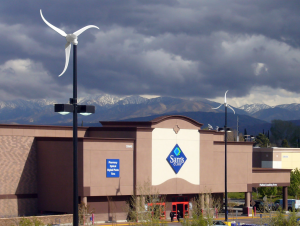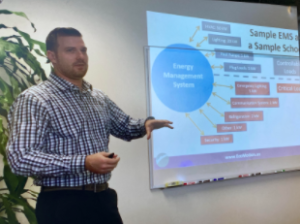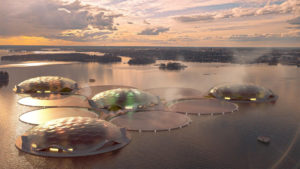April 20, 2021 – Volume 23, Issue 4
In This Issue
- Flanigan’s Eco-Logic: Denis Hayes Reflects on Earth Day
- Corporate Executives Push for Climate Action
- Microgrids 1.5: Critical Loads
- Repurposing Power Plants
- Constructing The Loop in Vegas
- Microbial Soil Sequestration
- Helsinki’s Offshore Thermal Energy Storage Concept
- The NetPositive Updates

Flanigan’s Eco-Logic: Denis Hayes Reflects on Earth Day
Fifty-one years is a long time… a good run. Certainly not a momentous year, or milestone. That was last year. But this year I launched The NetPositive Podcast and for our podcast’s first Earth Day, we feature an interview with Denis Hayes. He was the national coordinator of the first Earth Day in 1970, and founder of the Earth Day Network. He is credited with creating the largest secular movement in the world.
By 1990, Earth Day was “mobilizing” 200 million people in 190 countries. By now, and in collaboration with 75,000 partner organizations, Earth Day has mobilized a billion people worldwide. Denis is warm and thoughtful, well past his activist days but with convictions that haven’t changed a bit. He puts fledgling Earth Day in perspective, juxtaposing environmentalism with the Nixon administration, the Vietnam War, Cambodia, and Kent State. There was decency in Congress then. Members could and did come together to address air pollution – smog – and water pollution, the worst of which made so stark by the Santa Barbara oil spill.
I remember Earth Day in 1970, the roadside clean-up organized by East Woods School. This was the first Earth Day, announced in a full-page New York Times advertisement. Our gang pulled a ridiculous amount of trash out of the bushes along Yellowcote Road. People had thrown their bottles roadside for years. Some disposal system. Earth Day was about changing behavior, for me recycling. It was about demanding an end to rampant air pollution. It was about cleaning the water. Rachael Carson’s Silent Spring had shocked us all. Imagine a spring with no birds chirping gaily… long gone due to chemicals and toxins spewed into the environment by industry. This was the time of Love Canal, a tearful native American in a canoe… an awakening of American eco-consciousness.
President Nixon saw Mayor John Lindsay in New York attracting huge crowds on Earth Day and was simply jealous. He soon thereafter formed the Environmental Protection Agency (EPA) to shine the light in his direction. Shortly thereafter, the Clean Air Act, the Endangered Species Act, the Clean Water Act were signed into law. Many of us see the role that Earth Day played in forging a broad environmental coalition.
The Earth Day Network went after “the dirty dozen,” 12 members of Congress with particularly bad environmental voting records who were up for reelection. Because of the spotlight shined on their environmental records, seven of the 12 were defeated, and the political power of the environmental movement was proven.
Backing up a bit, it was Senator Gaylord Nelson, a junior senator from Wisconsin, who first envisioned “Environmental Teach-Ins” at universities across the country. Nelson recruited Denis – took him away from the Kennedy School of Government at Harvard – and made him the national coordinator. The idea of “Environmental Teach-Ins” morphed into “Environmental Rights Day,” and ultimately “Earth Day.” Some five months later… 20 million people took to the streets. According to Denis, there was a rare political alignment, Democrats and Republicans, rich and poor, could agree that we only have one planet and that we’d better take care of it. The Earth Day movement was about taking all these threads, weaving them together, and forming a nationwide rally. Walter Cronkite called it a “nationwide outpouring of mankind.” We were saving life from fouled skies and waters.
Earth Day held major events in 1970, 1990, 2000, 2010, and 2020. As the Energy Program Director at Rocky Mountain Institute, I spoke at Earth Day 1990 in Lincoln Park, Chicago. There were 100,000 people in the park, 20,000 in the stage area. I took the stage after Mayor Daily and Senator Paul Simon. “No, Chicago does not need nuclear… that’s dangerous and costly. Instead, Chicago needs energy efficiency, it’s safe and inexpensive…” I said with a compact fluorescent lightbulb held high to a thunderous applause. Those were the days.
The podcast features Denis’s story at the head of the Solar Energy Research Institute, later renamed the National Renewable Energy Laboratory (NREL) in Golden, Colorado. Denis was appointed by President Jimmy Carter with a mission to chart a pathway to get 20% of all energy use in America from renewables by the year 2000. Denis brought the best minds in from around the country to develop a renewable energy roadmap. But when Reagan took the presidency, in came the “dull grey men, in dull grey suits, walking dull grey hallways, thinking dull grey thoughts.” Quickly, Hayes finalized the research and shared it widely. U.S. Representative Richard Ottinger read the report into the public record. There was a new vision and roadmap, substantiating the claims and visions made by Amory Lovins and others. Later Brickhouse Publishing released the report as The New Prosperity. I have a copy in my library.
Denis is a class act and a friend that I have known since 1986. After a distinguished career in both academics and activism, he’s been at the helm of the Bullitt Foundation… a foundation that has had the mission of making the Northwest region exemplary in terms of sustainability. Today, Bullitt is even more laser-focused geographically, specifically supporting sustainability in a region west of the Cascades, from Portland to Vancouver, the so-called “Emerald Corridor.”
Bullitt’s headquarters in Seattle features a solar mortar-board solar array of note, and rainwater collection. It uses one-seventh the lighting energy stipulated in the building code. It makes a striking statement. Denis has made a lifetime of striking statements. Check him out on The NetPositive Podcast on Spotify, Apple, and Google.
Quote of the Week
“To restore the standing of the U.S. as a global leader, we need to address the climate crisis at the pace and scale it demands. Specifically, the U.S. must adopt an emissions reduction target that will place the country on a credible pathway to reach net-zero emissions by 2050. We, therefore, call on you to adopt the ambitious and attainable target of cutting GHG emissions by at least 50% below 2005 levels by 2030.”
Open Letter to President Biden from 310 Corporate Executives
Corporate Executives Push for Climate Action
 An impressive roster of 310 corporate leaders and investors signed an open letter to President Biden earlier this month indicating their support for the President’s commitment to climate action and setting ambitious targets for the United States’ new Nationally Determined Contribution (NDC) required by the Paris Agreement. The corporate leaders are asking the Biden administration to nearly double the emissions reduction targets set by the Obama administration. The letter was organized and published by We Mean Business and Ceres. The signatory businesses collectively represent over $3 trillion in annual revenue and employ 6 million workers in 50 states.
An impressive roster of 310 corporate leaders and investors signed an open letter to President Biden earlier this month indicating their support for the President’s commitment to climate action and setting ambitious targets for the United States’ new Nationally Determined Contribution (NDC) required by the Paris Agreement. The corporate leaders are asking the Biden administration to nearly double the emissions reduction targets set by the Obama administration. The letter was organized and published by We Mean Business and Ceres. The signatory businesses collectively represent over $3 trillion in annual revenue and employ 6 million workers in 50 states.
The 310 corporations are a diverse group: Google, Walmart, McDonalds, PG&E, Edison International, Apple, Coca-Cola, Ikea, Microsoft, Nike, Target, and Verizon to name a few. From Stonyfield Farms to Tiffany’s they hail. Also a signatory is the Altria Group, the parent company of the tobacco giant Philip Morris USA. Such companies have supported Republican platforms, but see eye-to-eye on the climate emergency. EVP and Chief Global Impact Officer for McDonalds, Katie Fallon, noted: “We have a responsibility to the nearly 40,000 communities we serve to protect the planet and build a more resilient and equitable future.”
The executives are calling on Biden to announce deep emissions reduction targets this month, in advance of the April 22 global summit on climate change. They are asking him to cut GHG emissions by 50% below 2005 levels by 2030. That’s what most environmental groups want and it’ now what these executives consider ambitious and attainable. President Obama had pledged to cut emissions by 26 – 28% below 2005 levels by 2025. Many environmentalists said that wasn’t enough. President Biden plans to announce his new goals on or around Earth Day and a virtual summit of world leaders that he is hosting.
Microgrids 1.5: Critical Loads
 In the last article in the 10-part series, we focused on the Santa Rita Union School District and how microgrids there were designed to cover average loads. As part of that project, we installed wireless thermostats to control HVAC. These loads would be cut in the event of a power outage, when each campus goes into “battery mode.” These are the times to cut loads.
In the last article in the 10-part series, we focused on the Santa Rita Union School District and how microgrids there were designed to cover average loads. As part of that project, we installed wireless thermostats to control HVAC. These loads would be cut in the event of a power outage, when each campus goes into “battery mode.” These are the times to cut loads.
Energy resilience is expensive stuff. The more resilience you want, the more it costs. Thus, it makes sense to identify what’s critical. What’s essential in a power outage? A computer system? A medical device? Don’t forget the coffee maker! EcoMotion is working with a number of sites now, slimming down the critical loads to about ~20% of the facility’s full load. Why so small? Again, to make resilience affordable. If you want 100%, you will pay dearly. At 20%, systems can often be financed at parity.
When developing microgrids, try to avoid this question: What do you want to back up? Why? Because it seems that everyone wants to back up everything. That’s expensive. Instead, we ask a fundamental question: What’s the purpose? What is this resiliency for? Is it to maintain refrigeration, or communications, or to provide for cell phone charging? Is it to power medical equipment or to maintain delicate scientific experiments? Is it to keep kids in school, data centers operational? This clarity defines our target.
So now with our resilience target in place, we dig in. We now know how much energy we need to store. Let’s say the purpose is to maintain the IT functions at a company; or to maintain refrigeration at a food-service facility. Those are the functions that are critical; those are the loads that constitute our design. We size the storage to cover these loads for the duration selected. Loads that are not critical are not backed. They might include air conditioning, resistance heating, architectural lighting, elevators, EV charging, and waterfalls.
So how to do it, how to limit the microgrid’s functioning in battery mode? If a facility has a sophisticated energy management system, it can be programmed to toggle back loads to critical only in “battery mode.” Many large buildings have custodial lighting and ventilation pre-programmed. They can be programmed for “battery mode.” Less sophisticated facilities do it the good, old-fashioned way…. humans taking actions buy generic priligy online such as turning off escalators, elevator banks, fountains… and even non-essential lighting. In schools, staff is instructed to steer clear of photocopiers during these periods.
Another strategy is to wire critical circuits into a subpanel. Only these circuits will be backed up when the grid goes down. In some instances, wiring a subpanel can be easy… mounting it right next to the main panel and rerouting select circuits. This is how PowerWalls are installed for household installations. In other cases, trying to wire critical loads into subpanels can be extremely challenging and just not worth it. Imagine a school campus with multiple buildings far afield. Controlling specific loads at the building level in this instance is near impossible. Another complicating factor for subpanels is trying to meld together loads operating on different phases in a three-phase system.
In some cases, wiring subpanels can be more expensive than adding more battery capacity to cover the entire load. Then you can forget about rewiring for critical loads altogether. That is what we did in Santa Rita Union Elementary School District. But remember that critical loads there are still in focus, relying on the energy management system to cut HVAC loads and trained administrators, teachers, and staff to cut off all other unnecessary loads.
The goal for sizing resilience is to enable a facility to get through night one. Then the sun comes up and solar recharges our microgrid… enough to operate that day in battery mode and get through night two. By carefully managing daily energy use, and only powering critical loads one way or another, solar + storage microgrids can operate indefinitely in a carbon-free mode.
Our colleague, Kirk Stokes, at MBL Energy stressed the importance of client expectations regarding microgrids given the high cost of batteries and resilience. “They have to understand that battery-mode operations are different than grid-connected times. You’ve got to set expectations: No HVAC. No electric appliances. That’s it. That’s how you create resilience at a reasonable cost.”
Repurposing Power Plants

Image Courtesy of Beloit College
It wasn’t too many years ago that coal was the dominant source of electric generating capacity in the United States. In the year 2000, coal still powered 50% of generation. In simplest terms, there were about 500 large coal-burning power plants nationwide generating half our power. Coal has been mined in 25 of the 50 states.
The Energy Information Administration (EIA) reported 241 coal plants still operating in 2019 Fully 290 plants had been closed since 2010 largely due lower cost and cleaner natural gas. Sierra Club updates the EIA data. Its Beyond Coal campaign reports that 339 coal plants have been shut down, 180,890 MW of coal-fired capacity, and that here are still 191 U.S. coal plants generating power.
So… what to do with an outdated coal plant? Many have been converted to natural gas. But the story is more colorful: Beloit College took a former Alliant Energy coal-fired power plant and turned it into a student union and recreation center. The old plant, now named the “Powerhouse” is situated on the bank of the Rock River houses a swimming pool, indoor track, café, meeting rooms, fitness space, lecture hall, and field house.
In Massachusetts, a 1,600 MW coal plant site is being demolished to make way for a logistical port and support center for wind turbines expected to be erected 35 miles offshore. A plant in Missouri is shopping proposals for repurposing… potentially a battery storage center or a biofuels manufacturing site.
There’s a company in St. Louis – Environmental Liability Transfer – that specializes in taking properties with environmental challenges and redeveloping them. It has purchased seven shuttered coal plants. It specializes in finding ways of re-using built infrastructure, like access to rail, ports, and water ways. Electrical infrastructure has value too.
Data centers use tremendous amounts of power and are now repurposing retired coal plants. In 2015 Google announced that it would buy the 1.6 GW Widow’s Creek coal-fired power plant located near Stevenson, Alabama. The plant was recently retired and had been operated by the Tennessee Valley Authority (TVA), generating nine billion kWh annually. It was known for having one of the tallest chimneys in the world at 1,001 feet. The smokestack was built in 1977 and removed in a controlled demolition in 2020.
Google announced that it would invest $600 million in the plant, retooling the existing power infrastructure, and converting the plant into a data center. The project broke ground in 2018, tapping into the transformers, power lines, and other equipment to bring clean power on site. Google will use river water to provide cooling to the servers.
In 2019, Google announced that it had reached a deal with TVA to purchase the output of several new solar farms… a combined 413 MW of power, 1.6 million solar panels. The deal committed Google to a $5 billion investment in renewable energy in the form of power purchase agreement. Quite a reversal, clean power coming in, versus decades of the dirtiest electricity generation going out.
In Ithaca, New York, owners of the Cayuga Power Plant announced that instead of overhauling the coal plant with natural gas, they were considering a shift to a solar-powered data center. Another data center is planned for the Somerset Operating Company’s 586 MW coal plant on the shore of Lake Ontario near Buffalo, New York. Plans are underway to convert nine shuttered coal plants in Pennsylvania. One is the Sunbury Generation plan, now partly demolished. Possible uses include a data center, warehouse, and grow house. But converting these plants is not always a walk in the woods: Experts point out that these plants sometimes come with big challenges, like ponds of coal ash, a hazardous residue from the burning of coal.
In related news, the Duane Arnold Energy Center in eastern Iowa is the site of a now-idle nuclear plant that will soon host a 690 MW solar farm. The 615 MW nuclear plant was 45 years old and slated to be decommissioned in 2022. A severe storm shut the facility a few months early. NextEra Energy of Florida will build the solar on 3,500 acres of land surrounding the plant. It will also install 60 MW of battery energy storage. The project will cost $700 million, will provide 300 construction jobs, and is slated to come online in 2023. NextEra Energy Resources currently has ownership interests in 3,160 MW of operating solar projects in 27 states.
Constructing The Loop in Vegas
The project began in 2019 at the Las Vegas Convention Center. Now tunnels, lights, action! The Loop has been built by Elon Musk’s Boring Company. It cost $47 million to build, fixed pricing. Four mini-tunnels, 1.7 miles in length, bored with the Godot Tunnel Boring Machine. Forty-feet below the convention center, the system was built in just over a year with zero road closures. Even with the convention center in full swing pre-covid, there were reportedly zero attendee disturbances. And now convention goers can be whisked from one end of the convention center to the other in two minutes.
Sixty-two Tesla cars of course, soon to be autonomous, will shuttle 4,400 passengers per hour. And Musk is not stopping there: The Boring Company is planning to expand the tunnel system to Vegas’s resorts and to the airport. The entire system — up and down the strip has been planned and submitted to the City. The Boring Company is promoting is as a completely different travel experience, Disney-like. The World of Concrete will be the first major convention event to use The Loop in June.
Microbial Soil Sequestration
 This right out of Wired magazine, an article that addresses two of the world’s most pressing problems: climate change and soil degradation. This “boils down to a simple imbalance… there is too much carbon in the air and not enough in the soil.” To a soil-tech start-up in Australia, the solution is patently obvious. The Soil Carbon Company specializes in “microbe-mediated carbon sequestration.” It’s a method of removing carbon from the atmosphere via microbial fungi and bacteria. A biological treatment applied to seeds prepares them to convert atmospheric carbon into a more stable compound that can be stored deep in the ground… potentially for centuries.
This right out of Wired magazine, an article that addresses two of the world’s most pressing problems: climate change and soil degradation. This “boils down to a simple imbalance… there is too much carbon in the air and not enough in the soil.” To a soil-tech start-up in Australia, the solution is patently obvious. The Soil Carbon Company specializes in “microbe-mediated carbon sequestration.” It’s a method of removing carbon from the atmosphere via microbial fungi and bacteria. A biological treatment applied to seeds prepares them to convert atmospheric carbon into a more stable compound that can be stored deep in the ground… potentially for centuries.
The special fungi are “dark septate endophytes” that live symbiotically within the roots of the host crop. In turn, carbon is captured through photosynthesis and then stored in a non-soluble form, in fungal melanin compounds. The process increases the water holding capacity of the soil. The Soil Carbon Company is now testing the fungi with crops such as canola, soybean, and wheat in Australia and the United States and hoping to bring it to market in 2021. Reportedly the technology is low cost and easy to adopt. All farmers have to do is to inoculate their crops with microbes, sold in freeze-dried form, and let nature take its course.
Helsinki’s Offshore Thermal Energy Storage Concept

Simulated Image Courtesy of Carlo Ratti Associati
The City of Helsinki plans to be carbon neutral by 2035. It has a goal of decarbonizing its district heating system by 2030. That’s not easy. It’s cold there and the heating demand is intense. There are no obvious solutions, so the City developed the Helsinki Energy Challenge. It offered a million Euro reward for anyone to come up with a viable alternative to fossil fuel use for heating the City’s hundreds of thousands of homes and buildings.
One of the competition’s winners is called Helsinki’s Hot Heart. It’s pretty far out… a vision of 10 floating reservoirs off the City’s coast that would store heat in seawater. The design has a recreational angle: Four of the ten reservoirs would have partially open roofs and would be open to visitors, featuring tropical plants and heated swimming pools.
Here’s how it would work: Renewable electricity would be used to run heat pumps to heat the seawater and store it in the floating reservoirs. When heat is needed, it would be sent to Helsinki’s district heating system, an existing network (toured by EcoMotion years ago) that provides hot water for household heating throughout the City.
This a type of thermal storage at an unprecedented scale. It could potentially be used by any coastal community, facing sea, lakes, or rivers. The architect, Carl Ratti, explains that water efficiently stores heat. “It is also easy to store seawater in basins in the sea because the water inside has similar pressure to the water outside, simplifying the structural requirements for construction.”
In related floating news, Singapore is now home to one of the world’s largest floating solar arrays. The 5 MW array will produce 6 million kWh annually, offsetting 4,258 tonnes of CO2. The Sunseap Group launched the solar farm in the Strait of Johor off Woodlands. It is made up of 13,312 panels, 40 inverters, and more than 30,000 floats.
The NetPositive Podcast Updates
 Recently Released:
Recently Released:
- This edition of EcoNet News, Volume 23, Issue #4 is also available in podcast format.
- The NetPositive Podcast: A Conversation with Angelina Galiteva, Chair, California ISO
- The NetPositive Podcast: A Conversation with Denis Hayes, Founder, The Earth Day Network
Check out The NetPositive with Ted Flanigan on Spotify, Apple, and Google.
Episodes includes Convos (Conservations), the News (EcoNet News), and Uni (the EcoMotion University).
